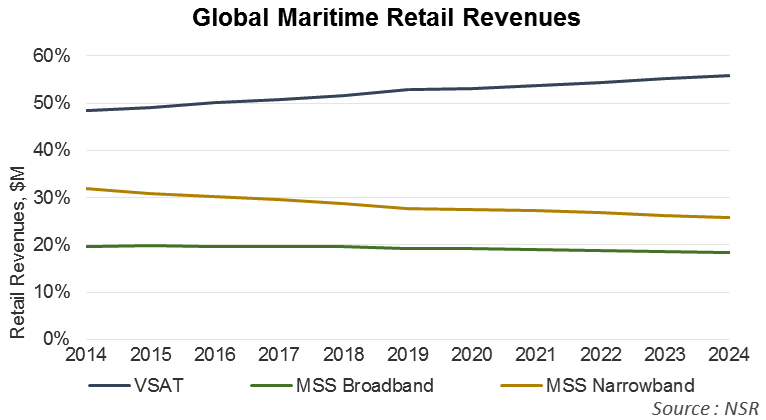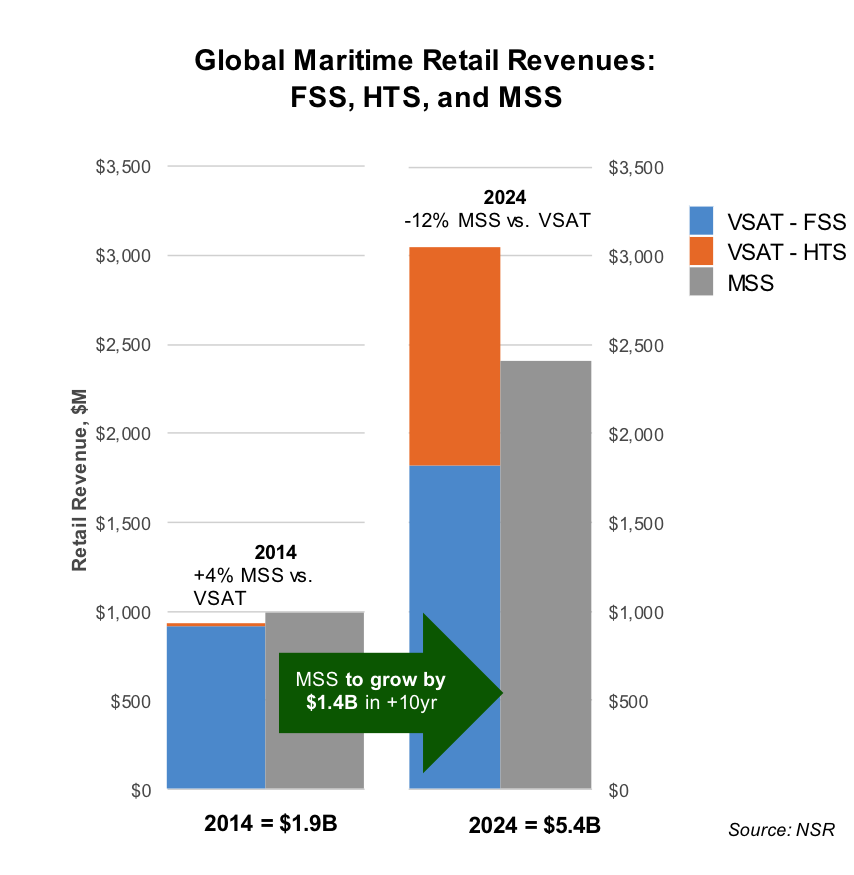Has VSAT Won the Maritime Market?
Jul 16th, 2015 by Brad Grady, NSR
With the focus of the industry on HTS vs. FSS, LEO; MEO or GEO; or C-
vs. Ku- vs. Ka-bands; it is sometimes easy to forget about the MSS
segment of the maritime sector. As the larger side of the maritime
market in 2014, both by In-service Units and retail revenues, it is
quickly becoming the ‘legacy’ part of the maritime satcom industry – not
just true legacy services such as Inmarsat-B, but MSS-enabled services
as a whole. For good reason, data and the demand for data is
changing the entire maritime market, from fishing vessels who need to
report their positions at regular intervals to the latest social media
service on cruise ships to the rapidly increasing number of sensors on
offshore or merchant vessels.

Data continues to drive the maritime market. Although it is
easy to paint a picture that VSAT is ‘winning' the maritime battle, and
by a lot of measures it is/not far off, there still remains a strong
market for MSS offerings; not only for critical safety-certified
applications, but as helping to enable the cycle of data consumption for
maritime customers. By NSR’s latest study of the maritime market,
NSR’s Maritime Satcom Markets, 3rd Edition there still
remains upwards of $1.4 Billion dollars’ worth of growth over the next
ten years for MSS maritime markets.
It is certainly true that a prime target for VSAT offerings will be
high usage MSS Broadband customers across the merchant, fishing,
offshore, and passenger segments. However, there still remain a
number of un-connected and under-connected vessels of all sizes in the
greater maritime segment who are still likely to start off with an MSS
connection as they start the ladder of data-addiction. Especially
where smaller vessels have typically forgone a satellite connection, the
changing dynamics of the maritime satcom market will continue to push
into these smaller vessel footprints, and other vessel demographics
where it simply doesn’t make sense to invest in VSAT infrastructure.

With both regulatory and business needs increasingly focused on
gathering, processing, and acting on ‘big data’, MSS narrowband can and
will remain a strong offering for tracking containers, fishing vessels,
or even within the leisure segment. Although these vessels and
applications will not be a significant per-unit source of revenue, with
upwards of hundreds of thousands of these in-service units to be in the
market by 2024, it provides an ongoing opportunity for what will become
‘legacy’ product offerings in the era of HTS. Just as we are
seeing across the space industry with nanosats and cubesats providing
new and innovative applications, cheap will not mean useless or
insignificant (or to be forgotten).
Bottom Line
Not even large numbers of In-service Units, emerging vessel tracking
requirements, situational awareness applications, or feeding ‘big data’
services can defeat an overall trend in the market – even fisherman need
more data. With safety-centric services evolving beyond a simple
voice or text alert into incorporating weather, sensor data, or video
feeds, the role of MSS in the maritime market will continue to evolve.
Yet, that evolution will not only serve to provide opportunities for
current service and application providers, but likely serve as the first
rung on the ladder of higher data demand. And, even at higher
bandwidth demand locations, connectivity will be a mix of both MSS and
VSAT, not an either/or set of solutions.
| |